Milestones in our Mission

The development of the Palm Beach County Trauma System spans 25 years.
2016
The Trauma System marks 25 years of service to Palm Beach County residents and visitors. Since May 1991, the Health Care District's Trauma System has treated more than 64,000 people, providing rapid-response care for more than 3,700 traumatically-injured patients each year.
2014
The District developed and received approval of instrument approach and departure procedures at Delray, Lakeside and St. Mary's Medical Centers. Authority to use the approach and departure procedures was granted by the Federal Aviation Administration. This infrastructure development expands program capabilities to enhanced use of the national airspace system and enables operations under the instrument flight rules, which enhances safety and access to helicopter transportation during periods of inclement weather.
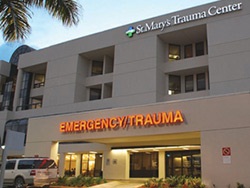 2012
2012
The Florida Department of Health conducts its Level 1 site survey at the Trauma Center at Delray Medical Center in May 2012.
St. Mary’s Medical Center submits its application to the Florida Department of Health for Level 1 certification for its Trauma Center.
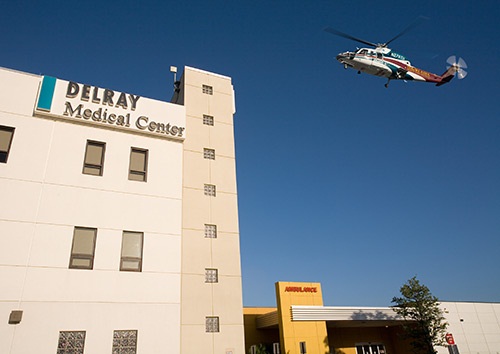 2011
2011
The Trauma Center at Delray Medical Center receives provisional verificatiDelray Medical Center facade with Trauma Hawkon from the Florida Department of Health to be a Level 1 Trauma Center. The Level 1 Status – the highest possible verification – enables the Trauma Center to provide an even more comprehensive level of adult and pediatric trauma care.
The Health Care District Board fully supports the process because it will provide an even stronger emergency care system for residents of Palm Beach County.
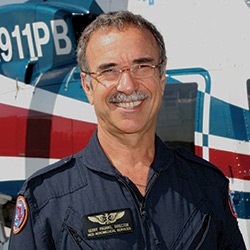 2010
2010
The Florida Department of Health and Florida EMS Pilots Association name Gerald M. Pagano, the Health Care District’s Director of Medical Transport and Aeromedical Facilities, “EMS Pilot of the Year” for his distinguished service since the start of the program.
Mr. Pagano piloted Trauma Hawk on its first life-saving mission in 1991 when the Trauma System was launched. In 2010 the Aeromedical Program extended its FAA certification to include Instrument Flight authorization.
2009
Installed satellite-based flight tracking systems on the Trauma Hawk helicopters enabling communications staff and program personnel to monitor aircraft position and other key indicators during all flight operations.
Coordinated with Lakeside Medical Center developers to provide a federally-approved and state-registered heliport with an instrument approach and departure procedure that supports interhospital transfers and landing operations for patients requiring air transport to a Trauma Center or other specialized facility from incident sites in this rural region.
Trauma Hawk landing at Lakeside Medical Center in Belle Glade 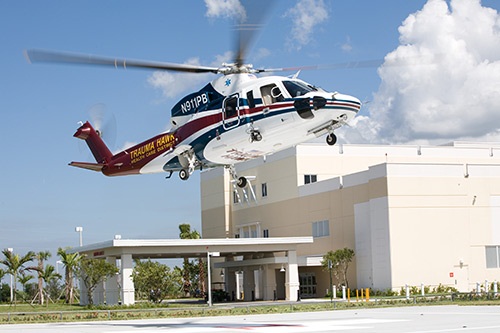
2006
The Health Care District constructs a new Aeromedical Hangar at Palm Beach International Airport. The 25,000 sq. ft. facility also includes administrative offices, a living facility for crews on overnight shifts, operations, pre-flight planning and communications center, and a training and meeting room.
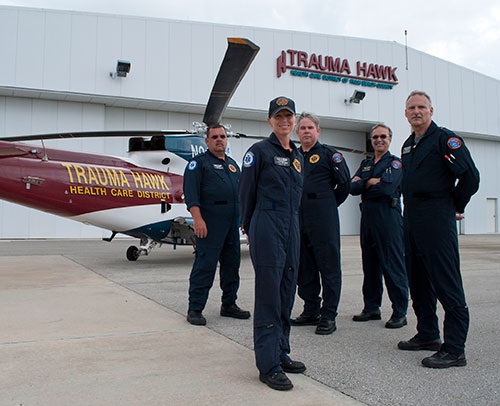 The Trauma Hawk flight crew at the Trauma Hawk Aeromedical Hangar in West Palm Beach
The Trauma Hawk flight crew at the Trauma Hawk Aeromedical Hangar in West Palm Beach
2001
The medical team on all flights was upgraded to include a Florida-licensed registered nurse who is also a state-certified paramedic and an additional state-certified paramedic.
1999
With the delivery of the new helicopters, the Health Care District assumes sole responsibility for piloting and maintaining the Trauma Hawks. The District leases space at Palm Beach International airport to house its aircraft and crew members, begins scenario-based simulator flight and classroom training for all pilots at Flight Safety International in West Palm Beach and institutes a standby process for aircraft flight requests, ensuring safer operations and reduced response times.
The Health Care District’s Trauma Agency upgrades its Trauma Registry computer system to enable faster and more systematic reporting of trauma statistics and improved quality management.
1998
The Health Care District purchases two Sikorsky S76-C+ Trauma Hawks to replace the original helicopter.
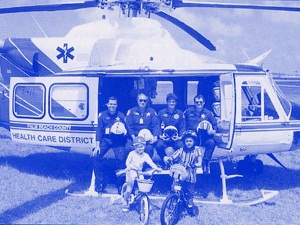 1997
1997
The Trauma System reduces the preventable trauma death rate in Palm Beach County from over 30 percent prior to 1990 to less than 1 percent – significantly better than the national average. The Trauma Agency manages injury prevention programs, such as Bicycle Safety, which encourages children to wear bike helmets.
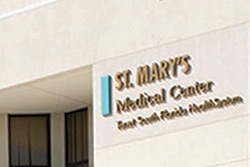 1996
1996
The Trauma Centers treat more than 2,000 trauma patients, and Trauma Hawk transports over 600 patients. The Florida Department of Health verifies St. Mary’s Trauma Center as a Pediatric Trauma Referral Center – the first in Palm Beach County.
1994
In February the Health Care District obtains the Federal Aviation Administration certification as an Air Carrier and develops a software program to record all Aeromedical flight activity. This ensures that the District’s Aeromedical Program complies with FAA regulatory oversight and standards and provides service with the highest possible degree of safety in the public interest. The District leases a similar aircraft to support the trauma services during periods its primary aircraft is out of service for maintenance.
1991
The Palm Beach County Board of Commissioners transfers the administration of the Trauma Agency from the County Office of Emergency Medical Services to the Health Care District.
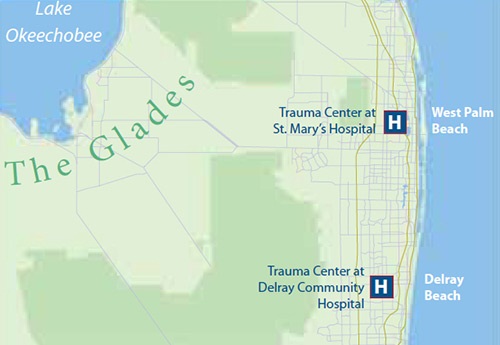 The Florida Department of Health provisionally designates Delray Community Hospital and St. Mary’s Hospital as Level 2 Trauma Centers. On May 1 the Trauma System makes its first lifesaving mission, as Trauma Hawk airlifts a trauma patient to the Trauma Center at St. Mary’s Hospital.
The Florida Department of Health provisionally designates Delray Community Hospital and St. Mary’s Hospital as Level 2 Trauma Centers. On May 1 the Trauma System makes its first lifesaving mission, as Trauma Hawk airlifts a trauma patient to the Trauma Center at St. Mary’s Hospital.
Air transport is critical for a region as geographically large as Palm Beach County, Florida’s largest county by land area. The eastern urban/suburban corridor is a full 50 miles north-to-south, while the large rural agricultural belt along Lake Okeechobee (the “Glades”) in the west is more than 35 miles from the Trauma Centers. Trauma Hawk is a critical factor in extending the safety net to residents and visitors in these rural communities.
1990
The Health Care District Board purchases a Trauma Hawk med-evac helicopter to be used for rapid transport of patients by air. By interlocal agreements, the Palm Beach County Sheriff’s Office provided pilots and maintenance staff for the Trauma Hawk, while Palm Beach County Fire Rescue provides medical personnel and ensures the State air ambulance licensing.
The Health Care District Board reviews recommendations made by a group of trauma consultants retained by the Board to identify the best qualified candidates for designation as Trauma Centers – specialized hospital facilities that provide trauma care and services 24 hours a day, seven days a week. The consultants evaluated four hospital applicants. Based on a review and site visits, the consultants recommend St. Mary’s Hospital and Delray Community Hospital as the best qualified. The District Board approves St. Mary’s Hospital as the designated North County Trauma Center and Delray Community Hospital as the designated South County Trauma Center.
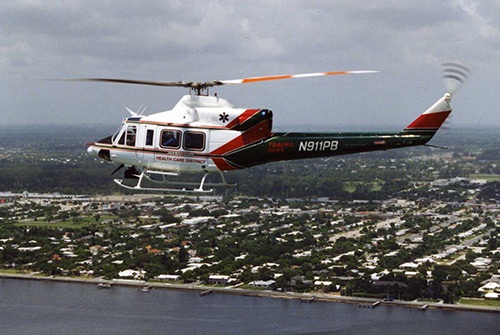 The Health Care District's first Trauma Hawk aeromedical helicopter
The Health Care District's first Trauma Hawk aeromedical helicopter
1989
The Board of County Commissioners forms the Palm Beach County Trauma Agency under the Palm Beach County Office of Emergency Medical Services to develop and administer a comprehensive, countywide Trauma System. At that point the population of Palm Beach County was 818,500. People who were seriously injured were transported to the nearest hospital’s Emergency Room by ground ambulance or the Palm Beach County Sheriff’s Office’s helicopter.
1988
In November Palm Beach County voters approve a referendum establishing the Palm Beach County Health Care District to plan, fund, and coordinate the delivery of health care, including trauma care.